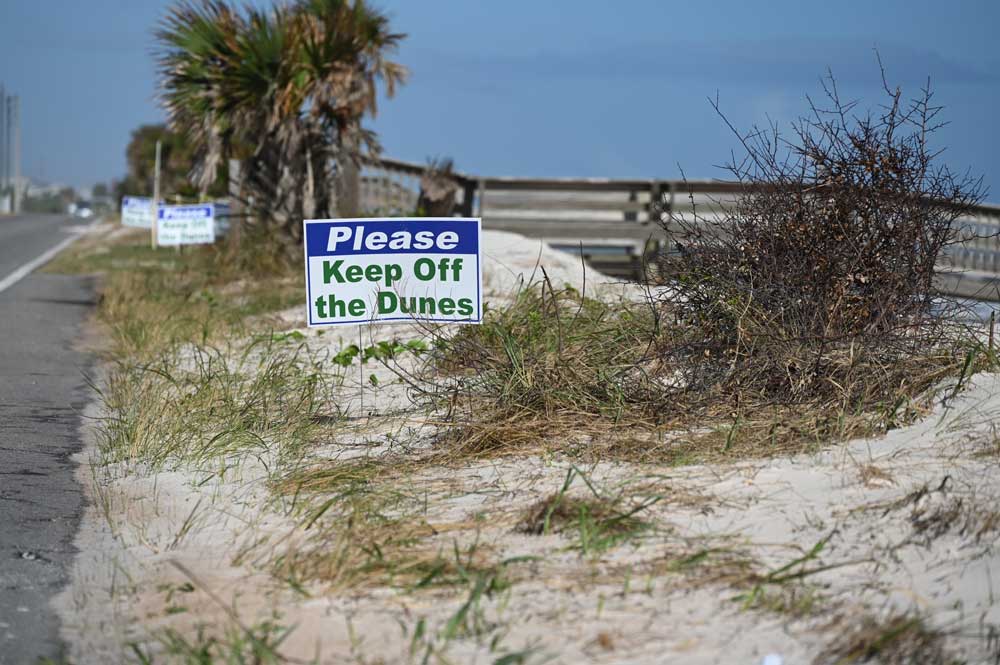
The Flagler County Commission on Monday is expected to approve an emergency order that criminalizes walking on dunes anywhere along the county’s 18 miles of shoreline. The penalty may be a $500 fine and 60 days in jail.
The order reflects several pulses of urgency: It is is prompted by an ongoing effort to maintain rebuilt dunes in the north of the county and a large-scale project starting in weeks that will rebuild dunes and the beach from North 7th Street in Flagler Beach down to the northern border of Gamble Rogers State Recreation Area. It is also an effort by the county to educate the public about the fragility of a dune system essential to the protection of land and property behind it, to the health of the beach, and to aesthetics that make Flagler County’s shore appealing.
Though most people don’t see it that way for lack of information or understanding, dunes are mini-ecosystems almost as fragile as coral, but above ground. “The materials of the beach are themselves steeped in antiquity,” once wrote Rachel Carson, the author of Silent Spring. “Sand is a substance that is beautiful, mysterious, and infinitely variable; each grain on a beach is the result of processes that go back into the shadowy beginnings of life, or of the earth itself.”

So to trample sand dunes with Timberlands or Fracaps or even callous and calloused bare feet causes disproportionate damage to a system already vulnerable to the accelerating ravages of erosion.
Flagler Beach has had a similar ordinance in place for years. But in Police Chief Matt Doughney’s recollection, no one has ever been criminally charged in a decade despite the city’s wealth of dunes, residents and visitors. The reason, Doughney said: sustained education. The city has implemented a “Dodge the Dunes” campaign through the Tourist Development Council and other educational approaches that have made arrests unnecessary.
“Compliance is the goal,” Doughney said, “and if you can educate somebody that’s not from here, once you educate them and they comply with what you want them to do, I think that’s paramount to being successful. So if you educate them and you don’t have repeat offenders, isn’t that what we should strive for?”
County Attorney Al Hadeed acknowledges Flagler Beach’s success. “Flagler beach has done an excellent job of keeping people off the dunes,” he said. “The tradition of not damaging the dunes is well established in Flagler Beach.” In the northern part of the county, “it’s a whole different situation, it’s a more rural beach.” And it can sometimes make dune protection challenging when some of the county’s subdivisions at the north end, including Sea Colony and the frontier-like jumble of Rollins, Flagler, Atlantic and Moody Drive to the north that all sprawl all the way to the beach.
“It is absolutely not a rule for the sake of a rule, it has a very significant foundation, and the law enforcement will be able to explain it, The signs we have put up have not worked,” Hadeed said.
The ordinance is not directed at Flagler Beach, though–redundancy aside–it can be invoked even there. Rather, it is directed at that northern portion, where more beach-goers walk on the dunes, engage in activities and “damaging them very significantly, weakening what we’ve spent mullions of dollars to perfect what we could.”
The county spent millions of dollars repairing dunes after Hurricanes Matthew and Irma in 2016 and 2017, dunes that eventually were eroded away, and again spent more millions–mostly underwritten by state dollars–to rebuild them. A joint federal and local project, funded with federal and state dollars, is about to dump upwards of a million cubic yards of sand south of North 7th Street.
County Commission Chair Andy Dance supports the approach. “From a health, safety and welfare standpoint, it’s been hard to regulate maintenance of the dune system,” Dance–who is also a landscape architect–said. “So this has been proposed as a way to be able to kind of combat that. We’ve seen the importance of the dune. Now let’s talk about the requirement to give the vegetation some time to establish an appropriate root system. Disturbing those things is the worst possible thing for the dunes.”
The prohibited area of a typical dune begins at its lowest point leeward from the crest to its lowest point seaward, where the vegetation line stops. near The order does not prohibit a property owner or a home owner association from using alternatives to walkovers, such as Mobi-mats, to access the beach.

The order is issued under the aegis of the state of emergency on the beaches that the County Commission has renewed weekly since Hurricane Matthew. The order would go in effect next week. It reads in part: “It is prohibited for any person to trample, walk, traverse, damage, or drive across or upon the dunes, including upon native vegetation naturally growing or planted to stabilize the dunes, other than to directly access the beach at access points designated by the County, a municipality or by the State Park System. This prohibition extends to the entire coastline of the County including within municipalities and including the entirety of any dune constructed or installed by the County in response to the hurricanes and coastal storms that have eroded the County’s beaches.”
Flagler Beach has protected its dunes in part because it has 52 public and private walkovers in the city. The county has many fewer, among them at five seaside county parks–Bay Drive Park, MalaCompra Road Park, 16th Road Park, also known as “Old Salt Park, Jungle Hut Road Park and Varn Park.
The county and, likely, the Sheriff’s Office, will look to Flagler Beach for its experience and advise on enforcement. “I appreciate Mr. Hadeed’s support of our education process here in Flagler Beach,” Doughney, the police chief, said. “This is a big project for the entire county and for Flagler Beach itself. A lot of our locals know about the dunes but there’s in my opinion a misperception what a sea dune looks like.” He said it’s not always the rolling dune people, especially visitors, imagine. Locally, its crest can often be parallel with the road, especially in areas where the shoreline is critically eroded. So education in person or through handouts and social media is key, Doughney said. “I think that’s what Mr. Hadeed was commending us for.”
When someone is found to be walking on a dune in Flagler Beach, typically the person is warned. It works, without repeat offenses. “I don’t think we’ve arrested anybody in the 10 plus years I’ve been here,” Doughney said. City police do write tickets for drivers who park on the dunes, however. That’s been more of an issue. But sea fencing installed over the last couple of years has very effectively protected the dunes.
“If this gets approved by Flagler County, I’ll be more than happy to reach out with the sheriff,” Doughney said, to share resources. “Education is the key.”
![]()
emergency-order-dunes








